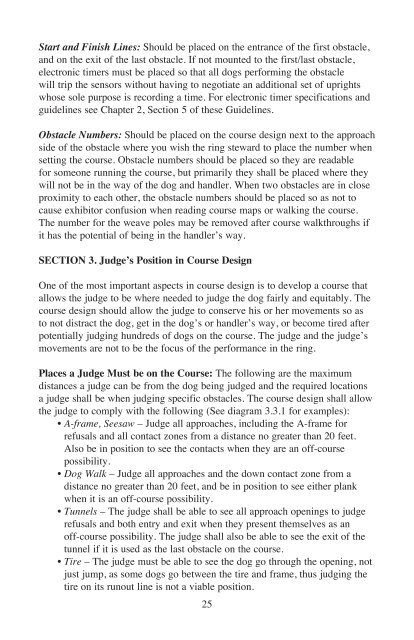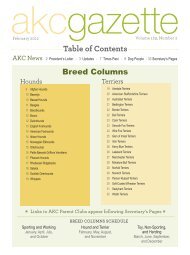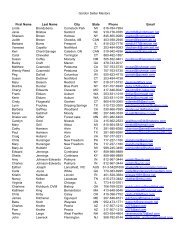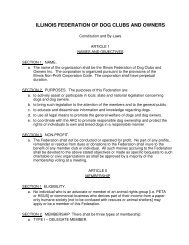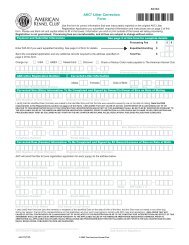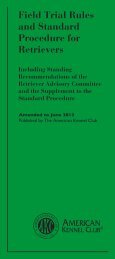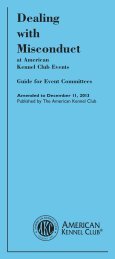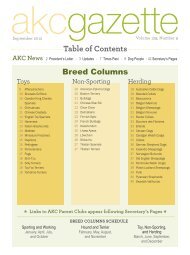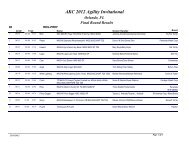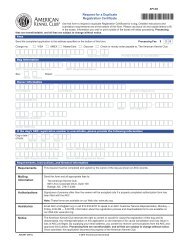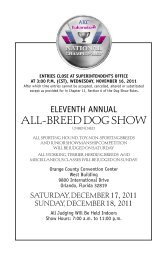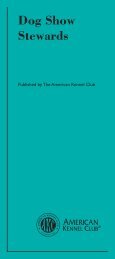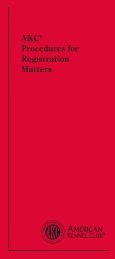Create successful ePaper yourself
Turn your PDF publications into a flip-book with our unique Google optimized e-Paper software.
Start and Finish Lines: Should be placed on the entrance of the first obstacle,<br />
and on the exit of the last obstacle. If not mounted to the first/last obstacle,<br />
electronic timers must be placed so that all dogs performing the obstacle<br />
will trip the sensors without having to negotiate an additional set of uprights<br />
whose sole purpose is recording a time. For electronic timer specifications and<br />
guidelines see Chapter 2, Section 5 of these <strong>Guidelines</strong>.<br />
Obstacle Numbers: Should be placed on the course design next to the approach<br />
side of the obstacle where you wish the ring steward to place the number when<br />
setting the course. Obstacle numbers should be placed so they are readable<br />
for someone running the course, but primarily they shall be placed where they<br />
will not be in the way of the dog and handler. When two obstacles are in close<br />
proximity to each other, the obstacle numbers should be placed so as not to<br />
cause exhibitor confusion when reading course maps or walking the course.<br />
The number for the weave poles may be removed after course walkthroughs if<br />
it has the potential of being in the handler’s way.<br />
Section 3. Judge’s Position in Course Design<br />
One of the most important aspects in course design is to develop a course that<br />
allows the judge to be where needed to judge the dog fairly and equitably. The<br />
course design should allow the judge to conserve his or her movements so as<br />
to not distract the dog, get in the dog’s or handler’s way, or become tired after<br />
potentially judging hundreds of dogs on the course. The judge and the judge’s<br />
movements are not to be the focus of the performance in the ring.<br />
Places a Judge Must be on the Course: The following are the maximum<br />
distances a judge can be from the dog being judged and the required locations<br />
a judge shall be when judging specific obstacles. The course design shall allow<br />
the judge to comply with the following (See diagram 3.3.1 for examples):<br />
• A-frame, Seesaw – Judge all approaches, including the A-frame for<br />
refusals and all contact zones from a distance no greater than 20 feet.<br />
Also be in position to see the contacts when they are an off-course<br />
possibility.<br />
• Dog Walk – Judge all approaches and the down contact zone from a<br />
distance no greater than 20 feet, and be in position to see either plank<br />
when it is an off-course possibility.<br />
• Tunnels – The judge shall be able to see all approach openings to judge<br />
refusals and both entry and exit when they present themselves as an<br />
off-course possibility. The judge shall also be able to see the exit of the<br />
tunnel if it is used as the last obstacle on the course.<br />
• Tire – The judge must be able to see the dog go through the opening, not<br />
just jump, as some dogs go between the tire and frame, thus judging the<br />
tire on its runout line is not a viable position.<br />
25


